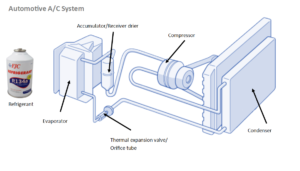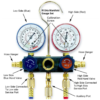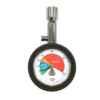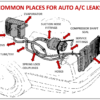A Layman’s Guide to Automotive A/C
Automotive air conditioning is a self-contained system which cools the cabin of a car by changing the phase of refrigerant from gas to liquid and back again by applying and releasing pressure on it. Each of the parts of the system is connected by tubing or hoses to form a closed loop through which the refrigerant flows. Since this is a continuous circle, there’s no specific start or end point; everything occurs simultaneously. However, we will start with the compressor; often considered to be the “heart” of the system

Refrigerant
The ability of refrigerant gas to change its physical properties as it is compressed and cooled is what makes the air conditioning system produce cool air.
Compressor
Like a heart, the compressor is a pump which pushes the refrigerant through the refrigerant line. As it pumps the refrigerant it also compresses it from a low pressure gas to a high pressure gas. This high pressure also heats the refrigerant. Because of its high pressure contents, this called the “high side” of the system.
Condenser
The next procedure occurs in the condenser. The hot, high-pressure refrigerant flows through the high-pressure tube towards the condenser. The condenser is a series of coils, similar to a radiator, which sits in front of the car’s actual radiator. As air passes over the condenser it removes heat from the refrigerant. The refrigerant condenses into a liquid as it cools (which is why it’s called a “condenser”).
Thermal Expansion Valve or Orifice Tube
The now-liquid refrigerant flows through high-pressure tubing back towards the dash, where it passes through a small valve. The valve restricts the flow of refrigerant allowing only a small amount through at a time, and also relieves the pressure created by the compressor. When the pressure is suddenly reduced, the refrigerant becomes very cold. Depending on the system, this valve is either a thermal expansion valve or an orifice tube. Since the pressure has been reduced, the refrigerant returns to a low-pressure gaseous state.
Evaporator
The cold, low-pressure refrigerant then goes into the evaporator: the only part of the air conditioning system that is actually in the passenger compartment. Since the refrigerant is cold now, an electric blower fan pushes the cold air through the vents and into the passenger cabin.
Since refrigerant has a very low boiling point, the hot air causes it to quickly evaporate back into a gas (which is why this part’s called the “evaporator”). As it evaporates, it absorbs heat from the air passing through.
Accumulator or Receiver/Drier
Next, the refrigerant enters into either a receiver drier or an accumulator. Although different, both devices function to filter the refrigerant and absorb any moisture from the system. After completing the loop, the refrigerant cycles through to the compressor through the low-pressure tube restarting the entire cycle, and repeating continuously.
LMK 2019





